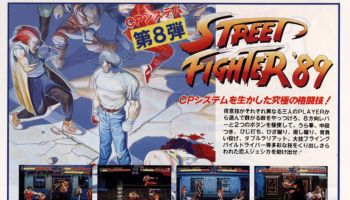
Bite-Sized Game History has reached way back to talk about a lot of video game firsts, and I’ve got a few more today.
So let’s get right to it and dig into the history of speed boosts, the working title for Final Fight, and Nintendo’s initial collaboration with Hyundai.
![]() You can find a lot of dedicated video game historians on Twitter, and in 280 characters or less, they always manage to unearth some amazing artifacts. Bite-Sized Game History aims to collect some of the best stuff I find on the social media platform.
You can find a lot of dedicated video game historians on Twitter, and in 280 characters or less, they always manage to unearth some amazing artifacts. Bite-Sized Game History aims to collect some of the best stuff I find on the social media platform.
Speed boosts have been part of arcade-style racing games for decades, but who did it first? Kate Willaert recently dug into this question and came up with an answer that might be more recent than you’d think.
Everyone remembers the the multi-colored chevrons that Nintendo included in 1984’s Excitebike. Running over the strips absolutely helped your bike keep its speed, but as Willaert points out, they weren’t boosters. According to the game’s instruction booklet, those chevrons were actually a Cool Zone on the track to prevent your bike from overheating.
So who did do it first?
Rare’s RC Pro-Am was the first game to feature speed boosts when it launched in early 1988. Rare referred to the strips as Zippers and they did momentarily add a small burst of speed to your car as it zipped around the track. Believe it or not, RC Pro-Am was also the first racing game to allow players to pick up a variety of power-ups on the track.
Nintendo was clearly paying attention, as they would later borrow both Zippers and the ability to pick up power-ups in Super Mario Kart:
You approach a set of arrows on the track. You instinctually know it's going to give you a speed boost. How do you know this? And where did it start?
Certainly not Excitebike. The arrows in that are a "cool zone" that cools down your engine. pic.twitter.com/7mLqa3NmM2
— "Critical Kate" ? Willaert (@katewillaert) August 20, 2019
Street Fighter and Final Fight have always shared a close lineage, even before Capcom implied that both games take place in the same universe in 1993’s Saturday Night Slam Masters. That mostly-forgotten arcade classic starred Biff Slamkovich (who refers to himself as one of Zangief’s best friends), as well as featuring an appearance from Final Fight‘s Mike Haggar. Later that same year, a character that strongly resembled Chun-Li would appear in the background of one of Final Fight 2‘s stages.
The two games would fully crossover in 1995’s Street Fighter Alpha, which added Final Fight‘s Guy to the character selection screen. The two franchises have spent the last 25 years sharing even more characters, though Mike Haggar has, shockingly, yet to make his Street Fighter debut. That wouldn’t be the case if Capcom’s original plan for the Fight Fight franchise had worked out.
As you can see in this recent post by NBA Jam author Reyan Ali, Final Fight began development as Street Fighter ’89, and would have served as a direct sequel to 1987’s Street Fighter. Capcom likely changed it to Final Fight to appease worried arcade operators that weren’t sure how to sell a game that differed so greatly from its predecessor:
Japanese arcade promo art for Capcom's Final Fight in its early form as Street Fighter '89. pic.twitter.com/J5ORv0nE3C
— NBA Jam (the book) (@nbajambook) July 6, 2019
Nintendo didn’t have a foothold in South Korea in the 1980s, but they still wanted to expand their growing video game empire and came up with a novel solution to sell the Nintendo Entertainment System in the country. Teaming up with Hyundai Electronics, the NES made its Korean debut as the Hyundai Comboy (presumably a portmanteau of Computer Boy). The console wasn’t very successful, so these photos recently shared by @game_whisperer might be one of the only times you’ll ever see it.
Hyundai COMBOY. No words. pic.twitter.com/Cl8r6Sq2V5
— Gamebrush Thriftwood (@game_whisperer) September 1, 2019
That does it for this edition of Bite-Sized Game History. Thanks to Kate Willaert, Reyan Ali, and @game_whisperer for sharing these short bits of video game trivia.

